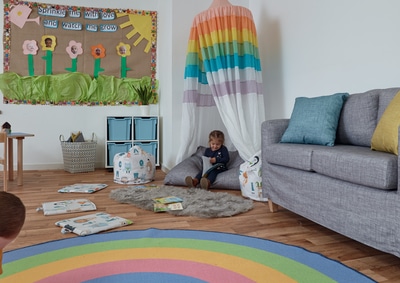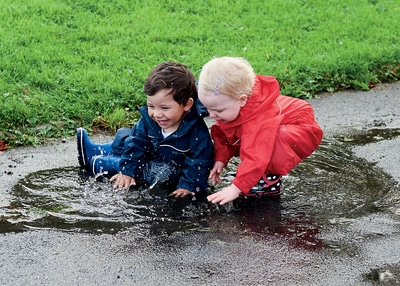Soothing with the senses – developing emotional regulation
Our senses help us ‘make sense’ of what is happening in the world outside our bodies. Learning to interpret the information coming in from the senses and then produce an appropriate response, is how young children develop language, social skills and motor coordination. A young child sees, hears and feels their way about the world, and depending on the feedback they get through their senses, quickly learns which movements work to get where they want to be, and which get a positive response from adults.
The senses also play a crucial role in children’s development of emotional regulation. When we are worried, stressed or upset, our sensory system becomes more ‘alert’ or sensitive to sensation. As adults, we have the skills to reason with ourselves in a stressful situation to help keep us calm e.g. thinking “It’ll be ok”, or “We’ll find a solution” etc. However, babies and young children have not yet developed the ability to reason and self-reflect. Practitioners therefore need to provide the sensory feedback to calm the child’s sensory system which in turn regulates their emotions i.e. to help them to feel calm. For example, providing calming sounds (like songs or using reassuring words), movements (like gentle rocking) touch (like cuddles or a favourite blanket) and tastes and smells in order to calm a crying/ emotionally dysregulated child.

Learning to self-sooth
Over time, the child (usually aged between 2-3 years) learns to do this for themselves (known as ‘self-soothing’). They may learn to suck their thumb, seek out that cuddly toy or rock themselves when upset. As the child gets older again (3-7 years old), they gradually begin to depend less and less on other people to feel calm and eventually begin to reason as an alternative calming strategy. However, this self- sufficient stage of emotional regulation depends on two essential factors being provided in the child’s early years; an attuned caregiver who can identify when a child is upset and respond promptly and appropriately and exposure to a variety of different sensory experiences so the child’s body can learn which sensations are calming and to integrate lots of sensations at once.
Within a nursery therefore, the approach to teaching and managing emotional regulation is also two-fold. Firstly, practitioners need to provide a nurturing, and safe environment and a consistent approach to managing emotions. This means having a consistent routine, clear rules and boundaries on behaviour and lots of rewards and positive reinforcement (smiles, stickers, high fives) for when children manage their emotions appropriately. Making sure all staff respond consistently and calmly is essential too. Try having different zones within the nursery e.g. a quiet/calm corner where children can choose to go if they are feeling upset/tired or overwhelmed for a quiet talk (once they are calm) or time with a book or toy.

Providing play opportunities
The second aspect to maintaining emotional regulation within a nursery is through providing plenty of opportunities for sensory based regulating activities. This means having a range of sensory play opportunities available to them such as; movement (e.g. swings and climbing equipment), textures (e.g. sand, water, playdough), sounds (music, quiet spaces) and books and pictures for them to look at.
Nature/outdoor play provides a wide range of sensory experiences and opportunities for young children to use their senses in different ways e.g. balancing on a log, walking through mud, crunching leaves, listening to birdsong, different smells of plants and flowers. Through being given space to explore their environment, young children learn to both challenge and calm their bodies through their senses

Developing emotional regulation
This expert article was kindly written by Inés Lawlor. An Occupational Therapist with over 20 years of experience, she has worked with children with neurodevelopmental conditions, intellectual disability and more recently mental health difficulties in clinics, home and education settings.
Related blogs
What Goes In, Must Go Out
Creating a Circular Economy in Your Nursery Author: Nick Corlett Sustainability Manager at LEYF Sustainability is more than a trend—it’s a shared responsibility, and the nursery is the perfect place to nurture these skills. Every day...
Top tips to create a SEND-Friendly Primary School Classroom
Author Lindsay Robinson Lindsay Robinson has been a primary school teacher for 23 years and is passionate about achieving the very best outcomes for children through quality first teaching and experiences. I remember receiving very little guidance during my teacher...
Celebrating being part of a Global Community
Author: Alice Sharp As a young teacher I can remember how much time and effort went into looking at the SHAP Calender. This is a calendar of festivals around the world. We had to try and ensure we celebrated anything relevant but also introduce other festivals from...


